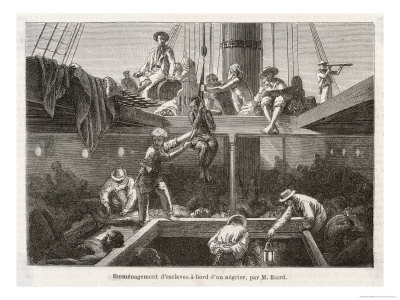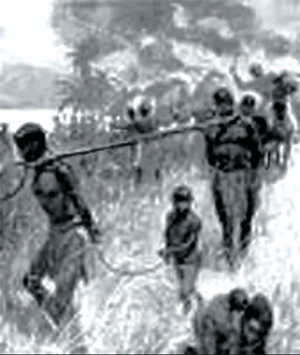African Slave Response and Resistance
Undoubtedly, the slave's most common response to his condition was one of submission. There was no hope of his returning to Africa, and there was no realistic expectation that the situation would be significantly altered. The hopelessness of his plight created a deep sense of apathy. However, even this acceptance of his master's values may have reflected African influences. It was common for a defeated tribe in West Africa to adopt the gods of its victors within the framework of its own religion. This attitude would have facilitated the African's adjustment to slavery in an alien culture.
The majority of slaves worked in the fields on large plantations. The majority of them were herded into large work gangs, supervised by overseers, and carefully directed in the accomplishment of whatever task was necessary for that day. Others were regularly assigned to a specific task without constant supervision and were held responsible for its completion. In this way it was possible for them to develop some sense of initiative. House slave were usually better off than field hands, but, because they lived in such proximity to their masters, they were much quicker to adopt the master's values and tended to be more obsequious.
Another significant group of slaves, both on the plantation and in the city, developed their talents and became skilled craftsmen: barbers, blacksmiths, carpenters, and a wide variety of other trades. Masters who could not fully utilize the skills of such a craftsman rented their property to their neighbors. In some cases, master permitted the slave to be responsible for hiring himself out and allowed him to keep some of the profits. The variety of experiences permitted within slavery allowed significant variations in the types of slaves who emerged.
Even apparently submissive slaves developed techniques of passive resistance. The laziness, stealing, lying, and faked illnesses, which were usually attributed to the slave's childlike behavior, may have been deliberate ways of opposing the system. Masters complained that many of their slaves were chronic shirkers. When slaves dragged their feet while working, it was seen as evidence of their inferiority. When white union workers behave similarly, it is labeled a slowdown.
Other slaves appear to have indulged in deliberate mischief, trampling down crops, breaking tools, and abusing livestock. A southern physician, Dr. Cartwright, concluded that this behavior was symptomatic of a mental disease peculiar to Africans. He labeled the disease Dysaethesia Aethiopica and insisted that masters were wrong in thinking that it was merely rascality. He also concluded that the slave's chronic tendency to run away was in reality the symptom of yet another African disease, Drapetomania, which he believed would eventually be medically cured.
Finally, some slaves engaged in active resistance. Most of the slave insurrections in America were very small, and most were unsuccessful. The three best known insurrections were those led by Gabriel Prosser, Denmark Vesey, and Nat Turner. These revolts will be treated more fully in the next chapter.
The masters consistently refused to see examples of passive or active resistance as signs of manhood. Lying and stealing were never interpreted as passive resistance, but were always attributed to an inferior savage heritage, as was slave violence. Prosser, Vesey, and Turner, instead of being numbered among the world's heroes fighting for the freedom of their people, were usually represented as something closer to savages, criminals, or psychopaths. Modern historical scholarship has been influenced by the interpretation of slave behavior, which stressed the impact of the system on the slave, rather than his response to it. Consequently, it has failed to give proper recognition to African contributions to American life.





















